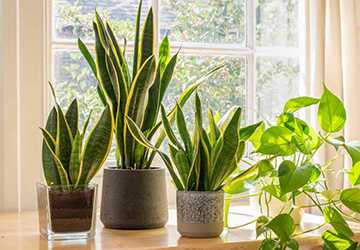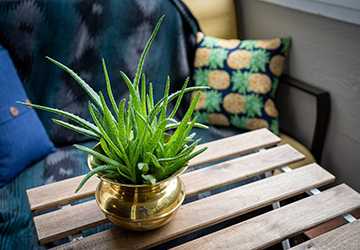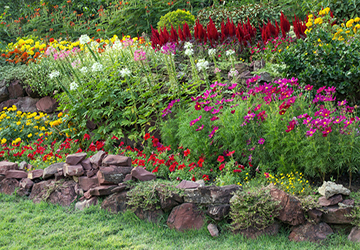Amidst the fast-paced demands of contemporary life, carving out time to care for our gardens can often seem challenging. However, that doesn't mean we must sacrifice the joys of greenery and nature in our living spaces. Fortunately, many low-maintenance botanical specimens exist, demonstrating survival and flourishing under minimal care.
These plants are ideal choices for individuals with hectic schedules, gardening novices, or anyone aspiring to imbue their surroundings with verdant aesthetics without the need for constant maintenance.
1. Snake Plant (Sansevieria trifasciata)
Why it's great: If you've ever walked into a space and been greeted by a tall, green plant with striking, sword-shaped leaves, chances are you've met a Snake Plant. Not only does it look chic and modern, but it's also one of the hardiest indoor plants around.

Maintenance Notes: This plant thrives on neglect. Please place it in indirect light and water it sparingly. The Snake Plant, also known as Sansevieria, acknowledged for its prowess in air detoxification, embodies a dual advantage by augmenting both aesthetic allure and the healthful quality of indoor air.
2. ZZ Plant (Zamioculcas zamiifolia)
Why it's great: The ZZ Plant is the epitome of resilience. Its lustrous, verdant leaves and erect growth habit render it a favoured choice for contemporary interior spaces. It's a slow grower, meaning it'll maintain its shape for years.
Maintenance Notes: Forgetful waterers, rejoice! The ZZ Plant stores water in its rhizomes, allowing it to go for weeks without a drink. Please place it in low to bright indirect light, and you're good to go.
3. Jade Plant (Crassula ovata)
Why it's great: With its fleshy, jade-green leaves and tree-like appearance, the Jade Plant brings a touch of the tropics to any space. Additionally, it is revered as a symbol of prosperity and auspicious fortune in numerous cultural contexts.
Maintenance Instructions: By its succulent nature, the Jade Plant manifests a proclivity for desiccation, indicating a preference for the soil to undergo complete dehydration before subsequent watering. It thrives in bright light but can withstand some shade. As a bonus, you can propagate new plants from its leaves, making it a fun project for gardeners of all levels.
4. Spider Plant (Chlorophytum comosum)
Why it's great: The Spider Plant is a classic for a reason. Its arching leaves, adorned with baby siderites, add a playful touch to any room. Plus, it's incredibly adaptable, thriving in a variety of conditions.
Maintenance Notes: Spider Plants are forgiving regarding light and water. They flourish in diffused light conditions but demonstrate resilience in partial shade. Water them when the top inch of soil is dry, and they'll reward you with cascades of baby plants.
5. Pothos (Epipremnum aureum)
Why it's excellent: Pothos is your plant if you want to add some greenery to your space without the hassle. Distinguished by its heart-shaped foliage and pendant vines, this specimen is ideally suited for placement in suspended containers or elegantly trailing from elevated surfaces such as shelves.
Maintenance Notes: Pothos is as low maintenance as they come. This specimen plant thrives in various light intensities, from soft to bright diffused light, requiring watering once the soil dries. Maintain a meticulous observation of its developmental progress for reasonable care.
6. Aloe Vera (Aloe barbadensis miller)
Why it's excellent: Aloe Vera is a beautiful addition to your home and a multi-purpose wonder plant. Celebrated for its curative gel, Aloe Vera stands out as a popular choice for its beneficial impact on health and visually appealing attributes.

Maintenance Notes: This succulent grows best in bright, indirect light and is remarkably tolerant of partial shade. Ensure a thorough yet infrequent watering regimen, allowing the soil to undergo total desiccation between intervals. Remarkably forgiving, Aloe Vera plants gracefully accommodate occasional lapses in the watering schedule.
7. Peace Lily (Spathiphyllum)
Why it's laudable: The Peace Lily is esteemed for its sophisticated alabaster blooms and opulent, sable-green leaves. It's not just a pretty face; it's also an excellent air purifier, making it a popular choice for indoor spaces.
Maintenance Notes: Peace Lilies prefer low to medium indirect light and consistently moist soil. However, they're forgiving if you occasionally let the soil dry out. Regular misting will also help keep them happy.
8. Air Plants (Tillandsia)
Why it's excellent: Air Plants are the epitome of low maintenance. These unique plants don't require soil and absorb nutrients and moisture from the air, making them incredibly adaptable and versatile.
Maintenance Notes: Mist your Air Plants with water weekly or immerse them in water for 30 minutes monthly. These plants flourish in bright, indirect light and can be creatively showcased, like in hanging terrariums or driftwood mounts.
9. Haworthia (Haworthia spp.)
Why it's excellent: Haworthias are charming succulents with distinctive rosette shapes and translucent leaves. Their small size makes them ideal for limited spaces, and they are recognized for their impressive architectural charm.
Maintenance Notes: Indigenous to arid landscapes, these desert-dwelling plants prefer vibrant, indirect illumination and soil with excellent drainage. Administer infrequent watering, allowing the soil ample intervals to desiccate between each hydration session. Haworthias are also known for their slow growth, maintaining compact shape with minimal care.
10. Cast Iron Plant (Aspidistra elatior)
Why it's excellent: The Cast Iron Plant lives up to its name by displaying remarkable resilience, thriving in neglect and low-light conditions. Its profound emerald hue and lustrous foliage confer an elegant ambience to any space.
Maintenance Notes: This tough-as-nails plant thrives in low light and can tolerate various conditions, including dry air and fluctuating temperatures. Water the plant sparingly, allowing the soil to dry between each watering session. With minimal effort and attention, the plant will thrive.
Conclusion:
Gardening extends beyond the care of plants; it involves crafting an environment that evokes joy, tranquillity, and a profound connection to the natural world. You can achieve this without feeling overwhelmed by the upkeep demands with the proper selection of low-maintenance plants. From the elegant Peace Lily to the quirky Haworthia, there's a low-maintenance plant for everyone.


